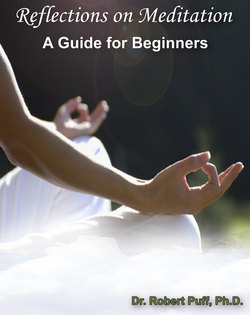Читать книгу Reflections on Meditation: A Guide for Beginners - Dr. Robert Ph.D. Puff PhD - Страница 10
На сайте Литреса книга снята с продажи.
8 Preparing to Meditate
ОглавлениеFor the greatest success, it is best to have a regular place to go to for meditation. I have found through the years that having a routine is helpful. Our bodies, souls, and minds seem to respond to this, knowing it’s time to relax, be peaceful, and meditate. So find a place in your home that is comfortable and relaxing, and say “this is my place to meditate.” It can be anywhere: your bed, a couch, a corner, a chair. Also, put up a do-not-disturb sign if there is the possibility of being interrupted. You want people to respect your need to be alone and to have a quiet place to meditate.
You may find with time that it doesn’t really matter where you meditate because you can get into the now with a pair of headphones and “zone out.” You can sometimes muffle the background noise, and once you get into that meditative place, it doesn’t matter what’s going on around you.
The nice thing about creating a routine in meditation is that it becomes easier with time. So tell your loved ones what you’re going to do, and they will probably cooperate. If you find that they don’t, try explaining to them that the few minutes it takes for you to connect with yourself each day means you’ll be a more patient and pleasant mom or dad, son or daughter, or roommate.
Sometimes you may need to get up a little earlier or stay up a little later to make the time to meditate, but those few extra minutes each day will prove beneficial to your whole day in the long run.
Another thing I find helpful is to do yoga or stretching before meditation to keep from getting too restless during meditation time. It’s best if you can sit quietly throughout the meditation. It’s okay if you cannot, but try to get to that goal. Stretching or yoga (also called “asanas”) help the body become relaxed and prepare it be still.
Eating can sometimes cause problems if you eat just prior to meditation. It makes it more difficult for your stomach to stay quiet, and this can be distracting. The mind just has a harder time settling down right after eating, especially after a full meal. It’s a better meditation when you haven’t eaten recently. So don’t meditate right after food if you can do it at any other time. A good routine is to get up and meditate in the mornings before breakfast and then enjoy your morning meal. In the evening, wait until just before bed, after dinner has digested, or meditate before dinner if that fits better into your routine.
Clothing has a bearing on meditation. It’s important that the body be comfortable. If possible, wear loose-fitting clothing when you meditate. It’s best not to wear a belt, wristwatch, or shoes, as these are somewhat restrictive. But if you’re meditating in a public place, you need not remove them.
So the general rules are: find a quiet, comfortable place to meditate. Stretch before you begin. Don’t mediate right after eating, and wear comfortable clothing. If you combine all of these things together, your experience with meditation will go well, and you will enjoy and look forward to it.
Of course, as with any new thing, beginning meditation can be challenging. Don’t give up. Stick with it, and keep trying. I’ve made many, many adjustments in my meditation throughout the years. Having flexibility and experimenting with new things is important. For a time you may enjoy a guided meditation, and then you may want to try breath meditation. Try different things, but stick to each one for a while. Have a routine. You will find your experience with meditation just gets better and better if you follow these suggestions.
